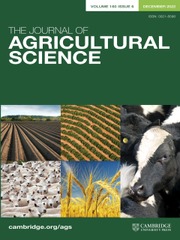Article contents
Differences between related grasses, times of year and plant parts in digestibility and chemical composition
Published online by Cambridge University Press: 27 March 2009
Summary
True dry matter digestibility, proportion of cell content, digestibility of cell wall, N and water-soluble carbohydrate were determined in eight related grasses in February, June and September in each of three years. In a separate experiment, true dry matter digestibility, proportion of cell content and digestibility of cell wall were determined in five plant parts of vegetative tillers of two grasses in February, April, June, August, October and December in each of two years.
Perennial ryegrass (Lolium perenne) was the most digestible grass and tall fescue (Festuca arundinacea) and Westerwolds ryegrass (Lolium multiflorum var. Westerwoldicum) were the least digestible. Italian ryegrass (Lolium multiflorum) was high in proportion of cell content, but not in digestibility of cell wall. Meadow fescue (Festuca pratensis) was high in digestibility of cell wall, but low in proportion of cell content. Perennial ryegrass and hybrid ryegrass were high, and tall fescue low, in both proportion of cell content and digestibility of cell wall. Ryegrasses were lower than fescues in concentration of N and higher than the fescues in water-soluble carbohydrate; ryegrass × meadow fescue hybrids were intermediate between the parent species in N and watersoluble carbohydrate.
Grass sampled in June and August was lower in both proportion of cell content and digestibility of cell wall than grass sampled at cooler times of year. Grass sampled in February was high in proportion of cell content and N, intermediate to high in digestibility of cell wall and intermediate in water-soluble carbohydrate.
Expanding leaf blades of perennial and Italian ryegrass were higher than expanded blades and sheaths in digestibility of cell wall and similar to expanded blades and higher than sheaths in proportion of cell content. Cell wall was less digestible in the tip than in the middle and basal portions of expanded leaf blades.
Information
- Type
- Crops and Soils
- Information
- Copyright
- Copyright © Cambridge University Press 1996
References
REFERENCES
- 15
- Cited by

